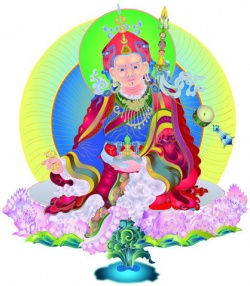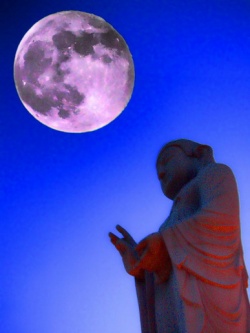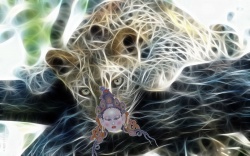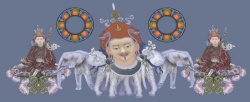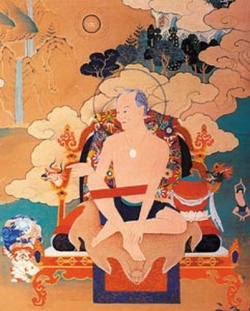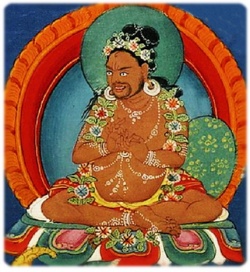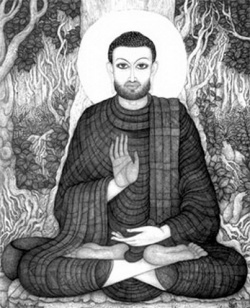Difference between revisions of "Ratnagotravibhāga (text)"
| (6 intermediate revisions by 3 users not shown) | |||
| Line 1: | Line 1: | ||
{{DisplayImages|1693|764|2007|110|1561|833|1901|1771|954|1367|1610}} | {{DisplayImages|1693|764|2007|110|1561|833|1901|1771|954|1367|1610}} | ||
<poem> | <poem> | ||
| − | The [[Ratnagotravibhāga]] ([[Sanskrit]]) (abbreviated as RgV) and its [[vyākhyā]] commentary (abbreviated RgVV), also known as the Uttara-tantra-shastra, are a compendium of the [[tathāgatagarbha]] {{Wiki|literature}}. The text was originally composed in [[Sanskrit]]. | + | |
| + | |||
| + | |||
| + | |||
| + | |||
| + | |||
| + | |||
| + | |||
| + | |||
| + | |||
| + | The [[Ratnagotravibhāga]] ([[Sanskrit]]) (abbreviated as RgV) and its [[vyākhyā]] commentary (abbreviated RgVV), also known as the [[Uttara-tantra-shastra]], are a compendium of the [[tathāgatagarbha]] {{Wiki|literature}}. | ||
| + | |||
| + | The text was originally composed in [[Sanskrit]]. | ||
The text and its commentary are also preserved in [[Tibetan]] and {{Wiki|Chinese}} translations | The text and its commentary are also preserved in [[Tibetan]] and {{Wiki|Chinese}} translations | ||
| Line 8: | Line 20: | ||
Authorship | Authorship | ||
| − | The text is attributed to a certain [[Sthiramati]] or [[Sāramati]] in the earlier {{Wiki|Chinese}} [[tradition]], while the [[Tibetan tradition]] considers the verse portion to have been composed by [[Maitreya-nātha]] and the prose commentary by [[Asanga]]. Ruegg suggests that the {{Wiki|Chinese}} and [[Tibetan]] [[traditions]] may be reconciled by [[understanding]] the [[name]] given in {{Wiki|Chinese}} sources as an [[epithet]] for [[Maitreya]].[c] | + | The text is attributed to a certain [[Sthiramati]] or [[Sāramati]] in the earlier {{Wiki|Chinese}} [[tradition]], while the [[Tibetan tradition]] considers the verse portion to have been composed by [[Maitreya-nātha]] and the prose commentary by [[Asanga]]. |
| + | |||
| + | Ruegg suggests that the {{Wiki|Chinese}} and [[Tibetan]] [[traditions]] may be reconciled by [[understanding]] the [[name]] given in {{Wiki|Chinese}} sources as an [[epithet]] for [[Maitreya]].[c] | ||
| + | |||
| + | The case for the involvement of [[Maitreya-nātha]] is also strengthened by the discovery of a [[Sanskrit]] fragment of the [[Ratnagotravibhāga]] in [[Saka]] [[script]] which mentions [[Maitreya-nātha]] as the author of the '[[root]]' ([[mūla]]) verses.[3] | ||
| + | |||
| + | The question of authorship may possibly be resolved by an analysis of the {{Wiki|structure}} of this multi-layered text. | ||
| − | + | {{Wiki|Takasaki}} [4] is certain that the author of the embedded commentary is [[Sāramati]] through his comparison of the RGV with the [[Dharmadhātvaviśeṣaśāstra]].[5] | |
| − | Peter Harvey finds the attribution to [[Asanga]] less plausible. | + | [[Peter Harvey]] finds the attribution to [[Asanga]] less plausible. |
Title | Title | ||
[[Ratnagotravibhāga]] | [[Ratnagotravibhāga]] | ||
| − | Nugteren [7] contextualizes the [[Buddhadharma]] 'inheritance' of the term '[[gotra]]' ([[Sanskrit]]) from the wider [[tradition]], where '[[gotra]]' literally means 'cowshed'.[d] In addition, literally, the term 'go' ([[Sanskrit]]) "{{Wiki|cow}}" also means "star", where star clusters are "herds" in the sky. | + | Nugteren [7] contextualizes the [[Buddhadharma]] 'inheritance' of the term '[[gotra]]' ([[Sanskrit]]) from the wider [[tradition]], where '[[gotra]]' literally means 'cowshed'.[d] |
| + | |||
| + | In addition, literally, the term 'go' ([[Sanskrit]]) "{{Wiki|cow}}" also means "[[star]]", where [[star]] [[clusters]] are "herds" in the sky. | ||
| + | |||
| + | The {{Wiki|cultural}} [[tradition]] of naming 'related groups; [[lineages]]' or "[[Gotra]]" of [[people]] after the founding [[rishi]] who are also called 'fathers' ([[Sanskrit]]: | ||
| − | + | [[Pitrs]]; particularly the "seven fathers") amongst the [[Saptarishi]] is also evident in [[Vedic astrology]] where the [[Saptarishi]] ([[seven rishis]]) are the [[seven stars]] of the [[constellation]] {{Wiki|Ursa Major}}. '[[Saptarishi nadi]]' is an important natal {{Wiki|augury}} tool in [[Vedic Astrology]]. | |
| − | [[Gotra]] evolved in [[Buddhadharma]] to first different [[spiritual]] [[lineages]] one of which (rather controversially within the broader [[tradition]]) according to their [[spiritual]] predisposition and constitution were doomed to cycle endlessly in the [[wheel]] of [[samsara]] without the intervention of a [[bodhisattva]], that is they would never attain [[bodhi]] of their own [[Wikipedia:Volition (psychology)|volition]], that [[doctrine]] in turn eventually evolved into the [[doctrine]] of [[Jina]]. | + | [[Gotra]] evolved in [[Buddhadharma]] to first different [[spiritual]] [[lineages]] one of which (rather controversially within the broader [[tradition]]) according to their [[spiritual]] [[predisposition]] and constitution were doomed to cycle endlessly in the [[wheel]] of [[samsara]] without the intervention of a [[bodhisattva]], that is they would never attain [[bodhi]] of their [[own]] [[Wikipedia:Volition (psychology)|volition]], that [[doctrine]] in turn eventually evolved into the [[doctrine]] of [[Jina]]. |
[[Jina]] now effectively is a herd of five [[gotras]] that upon taking certain [[initiation]] of [[mantra]] with associated [[vows]] and [[samaya]], every practicing [[Mantrika]] within the [[Mantrayana]] [[tradition]] takes upon conferral of their [[mantra]]. To return to the point of origin, [[Shakyamuni]] was within the [[gotra]] of the [[rishi]] [[Gautama]] [[Maharishi]] who was the revealer of [[mantras]] and the 'law' aspect of [[Dharma]]. | [[Jina]] now effectively is a herd of five [[gotras]] that upon taking certain [[initiation]] of [[mantra]] with associated [[vows]] and [[samaya]], every practicing [[Mantrika]] within the [[Mantrayana]] [[tradition]] takes upon conferral of their [[mantra]]. To return to the point of origin, [[Shakyamuni]] was within the [[gotra]] of the [[rishi]] [[Gautama]] [[Maharishi]] who was the revealer of [[mantras]] and the 'law' aspect of [[Dharma]]. | ||
| − | |||
| − | A secondary title for this work is [[Uttara-tantra-shastra]] (The [[Ultimate | + | |
| + | ===[[Uttara-tantra-shastra]]=== | ||
| + | |||
| + | A secondary title for this work is [[Uttara-tantra-shastra]] (The [[Ultimate Doctrine]]), by which [[name]] it is known in the [[Tibetan tradition]], and in translations from that [[tradition's]] {{Wiki|literature}} and commentaries. | ||
[[Gyatso]] conveys that '[[tantra]]' in the [[Tibetan]] title to specifically refers to the 'everlasting {{Wiki|continuum}} of the [[mind]]', the translation by [[Berzin]] of '[[mindstream]]' in English: | [[Gyatso]] conveys that '[[tantra]]' in the [[Tibetan]] title to specifically refers to the 'everlasting {{Wiki|continuum}} of the [[mind]]', the translation by [[Berzin]] of '[[mindstream]]' in English: | ||
| − | Here, since the text indicates primarily the cleansing of the everlasting {{Wiki|continuum}} of the [[mind]] when it is tarnished with fleeting stains, and thus since it concerns the everlasting [[mental]] {{Wiki|continuum}}, it includes the term [[tantra]], meaning everlasting {{Wiki|continuum}}, in its title. | + | Here, since the text indicates primarily the cleansing of the everlasting {{Wiki|continuum}} of the [[mind]] when it is tarnished with fleeting stains, and thus since it concerns the everlasting [[mental]] {{Wiki|continuum}}, it includes the term [[tantra]], meaning everlasting {{Wiki|continuum}}, in its title. |
| + | |||
| + | , the [[word]] [[tantra]] has the connotation of something that goes on and on with continuity, something that continues over [[time]] with [[connection]] from prior to later moments. We can undoubtedly understand something from that connotation as well. | ||
[[Transmission]] | [[Transmission]] | ||
| Line 35: | Line 61: | ||
Hookham affirms that there are [[precious]] few records of the RGV or RGVV (its commentary) in [[India]] and that their [[traditional]] recorded history commences with their 'rediscovery' by [[Maitripa]]. | Hookham affirms that there are [[precious]] few records of the RGV or RGVV (its commentary) in [[India]] and that their [[traditional]] recorded history commences with their 'rediscovery' by [[Maitripa]]. | ||
| − | Mathes relates a version of the [[traditional]] textual [[transmission]] of the RGV by [[Maitrīpa]] (ca. 1007-ca.1085) [e], and as well proffers his critical analysis that Maitrīpa's [[teachers]] [[Jñānaśrīmitra]] of [[Vikramaśīla]] and [[Ratnākaraśānti]] must have had access to the RGV, RGVV and/or their extracts: | + | Mathes relates a version of the [[traditional]] textual [[transmission]] of the RGV by [[Maitrīpa]] (ca. 1007-ca.1085) [e], and as well proffers his critical analysis that [[Maitrīpa's]] [[teachers]] [[Jñānaśrīmitra]] of [[Vikramaśīla]] and [[Ratnākaraśānti]] must have had access to the RGV, RGVV and/or their extracts: |
| − | [[Tradition]] has it that the [[Dharmadharmatāvibhaga]] and the [[Ratnagotravibhāga]] were rediscovered and taught by [[Maitrīpa]], but [[Maitrīpa's]] [[teacher]] at [[Vikramaśīla]], [[Jñānaśrīmitra]] (ca. 980-1040), must have already known these two works when he composed his [[Sākārasiddhiśāstra]] and [[Sākārasamgraha]]. [[Ratnākaraśānti]], another [[teacher]] of [[Maitrīpa]], also quotes the [[Ratnagotravibhāga]] in the [[Sūtrasamuccayabhāṣya]]. [[Maitrīpa]] passed the [[Dharmadharmatāvibhaga]] and the [[Ratnagotravibhāga]] on to *[[Ānandakīrti]] and [[Sajjana]]. | + | [[Tradition]] has it that the [[Dharmadharmatāvibhaga]] and the [[Ratnagotravibhāga]] were rediscovered and [[taught]] by [[Maitrīpa]], but [[Maitrīpa's]] [[teacher]] at [[Vikramaśīla]], [[Jñānaśrīmitra]] (ca. 980-1040), must have already known these two works when he composed his [[Sākārasiddhiśāstra]] and [[Sākārasamgraha]]. |
| + | |||
| + | [[Ratnākaraśānti]], another [[teacher]] of [[Maitrīpa]], also quotes the [[Ratnagotravibhāga]] in the [[Sūtrasamuccayabhāṣya]]. | ||
| + | |||
| + | [[Maitrīpa]] passed the [[Dharmadharmatāvibhaga]] and the [[Ratnagotravibhāga]] on to *[[Ānandakīrti]] and [[Sajjana]]. | ||
Textual versions | Textual versions | ||
[[Sanskrit]] | [[Sanskrit]] | ||
| − | The critical edition of the RGV in [[Sanskrit]] was first published by Johnston, et al. (1950) This critical edition of Johnston is founded on two manuscripts discovered by Rev. [[Rāhula]] Sāñkṛtyāyana (1893–1963) in [[Tibet]]. | + | The critical edition of the RGV in [[Sanskrit]] was first published by Johnston, et al. (1950) This critical edition of Johnston is founded on two [[manuscripts]] discovered by Rev. [[Rāhula]] Sāñkṛtyāyana (1893–1963) in [[Tibet]]. |
Of the complete extant [[Sanskrit]] [Johnston, et al. (1950)], [[Tibetan]] and {{Wiki|Chinese}} {{Wiki|manuscript}} versions, recension or interpolations of the RGV (according to {{Wiki|perspective}}), {{Wiki|Takasaki}} (1966) considered the {{Wiki|Chinese}} translation of a no longer extant [[Sanskrit]] text to be the oldest RGV {{Wiki|manuscript}} in [[existence]], though not necessarily truly representing the original [[Sanskrit]]. | Of the complete extant [[Sanskrit]] [Johnston, et al. (1950)], [[Tibetan]] and {{Wiki|Chinese}} {{Wiki|manuscript}} versions, recension or interpolations of the RGV (according to {{Wiki|perspective}}), {{Wiki|Takasaki}} (1966) considered the {{Wiki|Chinese}} translation of a no longer extant [[Sanskrit]] text to be the oldest RGV {{Wiki|manuscript}} in [[existence]], though not necessarily truly representing the original [[Sanskrit]]. | ||
| Line 55: | Line 85: | ||
[[Theg-pa-chen-po rgyud-bla-ma'i bstan-bcos rnam-par-bsad-pa]] ([[Mahāyāna-uttaratantra-śāstra-vyākhyā]]), Tohaku Catalogue No. 4025. | [[Theg-pa-chen-po rgyud-bla-ma'i bstan-bcos rnam-par-bsad-pa]] ([[Mahāyāna-uttaratantra-śāstra-vyākhyā]]), Tohaku Catalogue No. 4025. | ||
| − | Both of these versions were translated by [[Matiprajna]] ([[Sanskrit]], 1059–1109) (also known as: [[Ngok Loden Sherab]]; Wylie: [[Blo-ldan-shes-rab]]) under the guidance of [[Kashmiri]] [[Pandits]] '[[Ratnavajra]]' ([[Sanskrit]]) (Wylie: [[Rin-chen rdo-rje]]) and [[Sajjana]], conducted at [[Srinagar]] in [[Kashmir]], towards the close of the 11th century CE. | + | Both of these versions were translated by [[Matiprajna]] ([[Sanskrit]], 1059–1109) (also known as: [[Ngok Loden Sherab]]; [[Wylie]]: [[Blo-ldan-shes-rab]]) under the guidance of [[Kashmiri]] [[Pandits]] '[[Ratnavajra]]' ([[Sanskrit]]) ([[Wylie]]: [[Rin-chen rdo-rje]]) and [[Sajjana]], conducted at [[Srinagar]] in [[Kashmir]], towards the close of the 11th century CE. |
English Translations | English Translations | ||
[[Obermiller]] (1931) pioneered research into the RGV {{Wiki|literature}} in English [[language]] through his translation of the [[Tibetan]] RgVV under the [[name]] of the [[Uttara-tantra-shastra]], (the text's [[name]] in the [[Tibetan tradition]]), labeling it an example of {{Wiki|monism}}. | [[Obermiller]] (1931) pioneered research into the RGV {{Wiki|literature}} in English [[language]] through his translation of the [[Tibetan]] RgVV under the [[name]] of the [[Uttara-tantra-shastra]], (the text's [[name]] in the [[Tibetan tradition]]), labeling it an example of {{Wiki|monism}}. | ||
| − | The verse portion of the [[Ratna-gotra-vibhāga]] has been translated several times into English, including by [[E. Obermiller]] (1931) and Rosemary Fuchs (2000). The English translation by {{Wiki|Takasaki}} is the only English translation of the complete work, including the commentary. | + | The verse portion of the [[Ratna-gotra-vibhāga]] has been translated several times into English, [[including]] by [[E. Obermiller]] (1931) and Rosemary Fuchs (2000). |
| + | |||
| + | The English translation by {{Wiki|Takasaki}} is the only English translation of the complete work, [[including]] the commentary. | ||
Commentary on the [[Ratnagotravibhanga]] | Commentary on the [[Ratnagotravibhanga]] | ||
| − | To mitigate any {{Wiki|confusion}} or perhaps to bring uncertainty into [[awareness]], the RGV in certain textual [[transmissions]] has an embedded commentary RGVV that has become for the most part integrated with the RGV through the passage of [[time]] even though there are {{Wiki|distinct}} editions of the RGV and RGVV. {{Wiki|Takasaki}} (1966) provided a valuable textual analysis of the [[Sanskrit]] critical edition edited by Johnston with those versions preserved in certain editions of the {{Wiki|Chinese}} and [[Tibetan canon]]. {{Wiki|Takasaki}} (1966) identified a textual core of the RGV with the most {{Wiki|ancient}} verses of this core, dated ..., being extant in the {{Wiki|Chinese}}. The work of {{Wiki|Takasaki}} and Johnston has been critiqued by the extensive reviews of such [[scholars]] as deJong (1979) and {{Wiki|Lambert Schmithausen}} (1971) (in the {{Wiki|German}}). | + | To mitigate any {{Wiki|confusion}} or perhaps to bring uncertainty into [[awareness]], the RGV in certain textual [[transmissions]] has an embedded commentary RGVV that has become for the most part integrated with the RGV through the passage of [[time]] even though there are {{Wiki|distinct}} editions of the RGV and RGVV. |
| + | |||
| + | {{Wiki|Takasaki}} (1966) provided a valuable textual analysis of the [[Sanskrit]] critical edition edited by Johnston with those versions preserved in certain editions of the {{Wiki|Chinese}} and [[Tibetan canon]]. | ||
| + | |||
| + | {{Wiki|Takasaki}} (1966) identified a textual core of the RGV with the most {{Wiki|ancient}} verses of this core, dated ..., being extant in the {{Wiki|Chinese}}. | ||
| + | |||
| + | The work of {{Wiki|Takasaki}} and Johnston has been critiqued by the extensive reviews of such [[scholars]] as deJong (1979) and {{Wiki|Lambert Schmithausen}} (1971) (in the {{Wiki|German}}). | ||
Contents | Contents | ||
| − | The text consists of about 430 [[Sanskrit]] verses with a prose commentary ([[vyākhyā]]) that includes substantial quotations from [[tathāgata-garbha]] oriented [[sūtras]]. As well as a single extant [[Sanskrit]] version, translations [[exist]] in {{Wiki|Chinese}} and [[Tibetan]], though each of these versions show a [[degree]] of recensional variation. Extensive analysis of the critical [[Sanskrit]] text edited by Johnston (1950) with the [[Tibetan]] and {{Wiki|Chinese}} versions, identified that the verses actually comprise two separate groups: a core set of 27 verses ([[śloka]]) and 405 additional or supplementary verses of [[explication]] (Skt. [[kārikā]]). The work of Johnston, et al. (1950) and {{Wiki|Takasaki}} (1966) have been critiqued by the extensive reviews of such [[scholars]] as deJong (1979) and {{Wiki|Schmithausen}} (1971) (in the {{Wiki|German}}). | + | |
| + | The text consists of about 430 [[Sanskrit]] verses with a prose commentary ([[vyākhyā]]) that includes substantial quotations from [[tathāgata-garbha]] oriented [[sūtras]]. | ||
| + | |||
| + | As well as a single extant [[Sanskrit]] version, translations [[exist]] in {{Wiki|Chinese}} and [[Tibetan]], though each of these versions show a [[degree]] of recensional variation. | ||
| + | |||
| + | Extensive analysis of the critical [[Sanskrit]] text edited by Johnston (1950) with the [[Tibetan]] and {{Wiki|Chinese}} versions, identified that the verses actually comprise two separate groups: a core set of 27 verses ([[śloka]]) and 405 additional or supplementary verses of [[explication]] (Skt. [[kārikā]]). | ||
| + | |||
| + | The work of Johnston, et al. (1950) and {{Wiki|Takasaki}} (1966) have been critiqued by the extensive reviews of such [[scholars]] as deJong (1979) and {{Wiki|Schmithausen}} (1971) (in the {{Wiki|German}}). | ||
Interpretation | Interpretation | ||
[[Doctrinal]] significance | [[Doctrinal]] significance | ||
Final [[teaching]] | Final [[teaching]] | ||
| − | The secondary title for this work, [[Uttara-tantra-shastra]] (The [[Ultimate Doctrine]]), highlights the text's claim that the [[tathāgata-garbha]] teachings represent the final, definitive teachings of the [[Buddha]], in contrast to the earlier teachings on {{Wiki|emphasizing}} intrinsic [[emptiness]], such as contained in the [[Perfection | + | The secondary title for this work, [[Uttara-tantra-shastra]] (The [[Ultimate Doctrine]]), highlights the text's claim that the [[tathāgata-garbha]] teachings represent the final, [[definitive teachings]] of the [[Buddha]], in contrast to the earlier teachings on {{Wiki|emphasizing}} intrinsic [[emptiness]], such as contained in the [[Perfection of Insight Sutras]] ([[prajñā-pāramitā]]) and other [[Mahāyāna scriptures]]. |
| + | |||
| + | In addition to the group of [[scriptures]] known as the [[Tathāgata-garbha sūtras]], this work is the cornerstone of the [[tathāgata-garbha]] trend of [[thought]] in [[Mahāyāna Buddhism]]. | ||
[[Buddha-nature]] | [[Buddha-nature]] | ||
| − | The [[Ratnagotravibhaga]] is notable for its exploration of the [[doctrine]] of the "[[buddha nature]]" [f], the [[view]] that all [[sentient beings]] are already [[buddhas]] or have the propensity to attain [[buddhahood]]. | + | The [[Ratnagotravibhaga]] is notable for its exploration of the [[doctrine]] of the "[[buddha nature]]" [f], the [[view]] that all [[sentient beings]] are already [[buddhas]] or have the {{Wiki|propensity}} to attain [[buddhahood]]. |
The [[Uttaratantra]] takes as its key topic the [[idea]] of the [[dhatu]] of the [[Buddha]] which is {{Wiki|present}} in all [[beings]]: | The [[Uttaratantra]] takes as its key topic the [[idea]] of the [[dhatu]] of the [[Buddha]] which is {{Wiki|present}} in all [[beings]]: | ||
| − | The [[principal]] [[subject]] matter of this treatise is the special {{Wiki|theory}} of [[Dhatu]] (fundamental [[element]]) of the [[Absolute]] ([[Tathagata-garbha ]]= [[essence of Buddha]])... It is an [[exposition]] of the {{Wiki|theory}} of the [[Essence of Buddhahood]] ([[tathagata-garbha]]), the fundamental [[element]] ([[dhatu]]) of the [[Absolute]], as [[existing]] in all [[sentient beings]]. ... This [[element]] which had been regarded as an active force ([[bija]]) before, is regarded, in this text, as [[eternal]], quiescent and unalterable, as the true [[essence]] of every [[living being]] and source of all [[virtuous]] qualities.' | + | The [[principal]] [[subject]] {{Wiki|matter}} of this treatise is the special {{Wiki|theory}} of [[Dhatu]] (fundamental [[element]]) of the [[Absolute]] ([[Tathagata-garbha ]]= [[essence of Buddha]])... |
| + | |||
| + | It is an [[exposition]] of the {{Wiki|theory}} of the [[Essence of Buddhahood]] ([[tathagata-garbha]]), the fundamental [[element]] ([[dhatu]]) of the [[Absolute]], as [[existing]] in all [[sentient beings]]. ... | ||
| + | |||
| + | This [[element]] which had been regarded as an active force ([[bija]]) before, is regarded, in this text, as [[eternal]], quiescent and unalterable, as the true [[essence]] of every [[living being]] and source of all [[virtuous]] qualities.' | ||
| + | |||
Completion of [[sunyata]] | Completion of [[sunyata]] | ||
| + | |||
Within [[tathagatagarbha]] {{Wiki|literature}} a completion of [[sunyata]] ([[emptiness]]) {{Wiki|theory}} and an emphasising of [[metaphysics]] and [[mysticism]] can be found: | Within [[tathagatagarbha]] {{Wiki|literature}} a completion of [[sunyata]] ([[emptiness]]) {{Wiki|theory}} and an emphasising of [[metaphysics]] and [[mysticism]] can be found: | ||
| − | The [[Uttaratantra]] is a [[Mahayana]] text with emphasis on [[Buddhist]] [[metaphysics]] and [[mysticism]] [...] [[Tathagata-garbha]] [[thought]] is complementary to [[sunyata]] [[thought]] of the [[Madhyamika]] and the [[Yogacara]], as it is seen in the [[Uttaratantra]]. The [[Uttaratantra]] first quotes the [[Srimala-devi-sutra]] to the effect that [[tathagata-garbha]] is not accessible to those outside of [[sunya]] [[realization]] and then proceeds to claim that [[sunyata]] [[realization]] is a necessary precondition to the [[realization]] of [[tathagata-garbha]]. There is something positive to be [[realized]] when one’s [[vision]] has been cleared by [[sunyata]]. The [[sunyata]] teachings of the [[prajna-paramita]] are true but incomplete. They require further elucidation, which is found in the [[Uttaratantra]].' | + | The [[Uttaratantra]] is a [[Mahayana]] text with {{Wiki|emphasis}} on [[Buddhist]] [[metaphysics]] and [[mysticism]] [...] [[Tathagata-garbha]] [[thought]] is complementary to [[sunyata]] [[thought]] of the [[Madhyamika]] and the [[Yogacara]], as it is seen in the [[Uttaratantra]]. |
| + | |||
| + | The [[Uttaratantra]] first quotes the [[Srimala-devi-sutra]] to the effect that [[tathagata-garbha]] is not accessible to those outside of [[sunya]] [[realization]] and then proceeds to claim that [[sunyata]] [[realization]] is a necessary precondition to the [[realization]] of [[tathagata-garbha]]. | ||
| + | |||
| + | There is something positive to be [[realized]] when one’s [[vision]] has been cleared by [[sunyata]]. | ||
| + | |||
| + | The [[sunyata]] teachings of the [[prajna-paramita]] are true but incomplete. | ||
| + | |||
| + | They require further elucidation, which is found in the [[Uttaratantra]].' | ||
The [[Uttaratantra]] constitutes a higher [[Buddhist doctrine]] than that of [[sunyata]] as found in the [[prajnaparamita sutras]]: | The [[Uttaratantra]] constitutes a higher [[Buddhist doctrine]] than that of [[sunyata]] as found in the [[prajnaparamita sutras]]: | ||
| − | The [[sunyata]] teachings in the [[Prajna-paramita]] are true, but incomplete. They require still further elucidation, which the [[Uttaratantra]] provides. Thus it assumes the [[Prajna-paramita]] teachings as the [[purva]] or [[prior teachings]], and the [[tathagata-garbha]] teachings as the [[uttara]], in the [[sense]] of both subsequent and {{Wiki|superior}}.' | + | The [[sunyata]] teachings in the [[Prajna-paramita]] are true, but incomplete. |
| + | |||
| + | They require still further elucidation, which the [[Uttaratantra]] provides. | ||
| + | |||
| + | Thus it assumes the [[Prajna-paramita]] teachings as the [[purva]] or [[prior teachings]], and the [[tathagata-garbha]] teachings as the [[uttara]], in the [[sense]] of both subsequent and {{Wiki|superior}}.' | ||
Positive [[understanding]] of [[sunyata]] | Positive [[understanding]] of [[sunyata]] | ||
| Line 99: | Line 164: | ||
[[Purity]] | [[Purity]] | ||
| − | The [[tathagatagarbha]] is ultimately identifiable as the [[dharmakaya]].[g] These elevated qualities make of the [[Buddha]] one to whom [[devotion]] and adoration could be given: | + | The [[tathagatagarbha]] is ultimately identifiable as the [[dharmakaya]].[g] |
| + | |||
| + | These elevated qualities make of the [[Buddha]] one to whom [[devotion]] and adoration could be given: | ||
Here there is an elevation and adoration of [[Buddha]] and his [[attributes]], which could be a significant basis for [[Mahayana]] devotionalism.’ | Here there is an elevation and adoration of [[Buddha]] and his [[attributes]], which could be a significant basis for [[Mahayana]] devotionalism.’ | ||
| Line 105: | Line 172: | ||
{{Wiki|Exegetical}} [[tradition]] | {{Wiki|Exegetical}} [[tradition]] | ||
| − | Notable exegetes of the [[Ratnagotravibhaga]] have been [[Dolpopa]], [[Go Lotsawa]], [[Gyaltsap Darma Rinchen]], and [[Ju Mipham]], amongst others. | + | Notable [[Wikipedia:Exegesis|exegetes]] of the [[Ratnagotravibhaga]] have been [[Dolpopa]], [[Go Lotsawa]], [[Gyaltsap Darma Rinchen]], and [[Ju Mipham]], amongst others. |
| + | |||
| + | The [[Nyingma]] commentary of [[Ju Mipham]] from a [[Dzogchen]] [[view]], has been rendered into English by Duckworth (2008). | ||
| + | |||
| + | [[Khenchen Namdrol Rinpoche]] (2008/2009) commenced the [[Rigpa Shedra]] teachings on [[Mipham's]] [[view]] of [[Buddha Nature]] which has been followed by [[Khenpo Dawa Paljor]] (2009) of [[Rigpa]] [[Shedra's]] oral [[word]] by [[word commentary]] of [[Ju Mipham's]] {{Wiki|exegesis}} of RGV (RGVV?)in [[Tibetan]] with English translation ([[translator]] presently unknown). | ||
| + | |||
| − | |||
[[Dzogchen]] [[view]] | [[Dzogchen]] [[view]] | ||
| + | |||
| + | |||
This article possibly contains original research. Please improve it by verifying the claims made and adding inline citations. Statements consisting only of original research may be removed. (May 2009) | This article possibly contains original research. Please improve it by verifying the claims made and adding inline citations. Statements consisting only of original research may be removed. (May 2009) | ||
Seven [[Diamond]] Points | Seven [[Diamond]] Points | ||
| − | The [[Ratnagotravibhaga]] contains a synthesis of [[Sugatagarbha]] [h] {{Wiki|literature}} [i] into five chapters that distill seven '[[diamond]] points' ([[vajrapada]]): | + | The [[Ratnagotravibhaga]] contains a {{Wiki|synthesis}} of [[Sugatagarbha]] [h] {{Wiki|literature}} [i] into five chapters that distill seven '[[diamond]] points' ([[vajrapada]]): |
| − | '[[Buddha]]' ([[Sanskrit]]: ; Wylie: [[sañs-rgyas]]; {{Wiki|Chinese}}:) | + | '[[Buddha]]' ([[Sanskrit]]: ; [[Wylie]]: [[sañs-rgyas]]; {{Wiki|Chinese}}:) |
| − | '[[Dharma]]' ([[Sanskrit]]: Wylie: [[chos]]; {{Wiki|Chinese}}:) | + | '[[Dharma]]' ([[Sanskrit]]: [[Wylie]]: [[chos]]; {{Wiki|Chinese}}:) |
| − | '[[Saṃgha]]' ([[Sanskrit]]: [[gaṇa]]; Wylie: [[dge-'dun]]; {{Wiki|Chinese}}:) | + | '[[Saṃgha]]' ([[Sanskrit]]: [[gaṇa]]; [[Wylie]]: [[dge-'dun]]; {{Wiki|Chinese}}:) |
| − | '[[Essence]]' ([[Sanskrit]]: [[dhātu]]; Wylie: [[khams]]; {{Wiki|Chinese}}:) | + | '[[Essence]]' ([[Sanskrit]]: [[dhātu]]; [[Wylie]]: [[khams]]; {{Wiki|Chinese}}:) |
| − | '[[Awakened]]' ([[Sanskrit]]: [[bodhi]]; Wylie: [[byañ-chub]]; {{Wiki|Chinese}}:) | + | '[[Awakened]]' ([[Sanskrit]]: [[bodhi]]; [[Wylie]]: [[byañ-chub]]; {{Wiki|Chinese}}:) |
| − | '[[Qualities]]' ([[Sanskrit]]: [[guna]]; Wylie: [[yon-tan]]; {{Wiki|Chinese}}:) | + | '[[Qualities]]' ([[Sanskrit]]: [[guna]]; [[Wylie]]: [[yon-tan]]; {{Wiki|Chinese}}:) |
| − | '[[Activities]]' ([[Sanskrit]]: [[karman]]; Wylie: [[phyin-las]]' {{Wiki|Chinese}}:) | + | '[[Activities]]' ([[Sanskrit]]: [[karman]]; [[Wylie]]: [[phyin-las]]' {{Wiki|Chinese}}:) |
| − | In the [[tantric]] [[twilight language]] of correspondence the [[triratna]] of [[Sangha]], [[Dharma]] and [[Buddha]] are [[Body]], {{Wiki|Voice}} and [[Mind]] (and qualities and [[activities]]). | + | In the [[tantric]] [[twilight language]] of [[correspondence]] the [[triratna]] of [[Sangha]], [[Dharma]] and [[Buddha]] are [[Body]], {{Wiki|Voice}} and [[Mind]] (and qualities and [[activities]]). |
According to Norbu, all five of these, [[body]] (sku), {{Wiki|voice}} ([[gsung]]), [[mind]] ([[thugs]]), qualities ([[yon tan]]), [[activities]] ([[phrin las]]), constitute a '[[mindstream]]' or '{{Wiki|continuum}} of being' of either a [[sentient being]] (with adventitious [[obscurations]]) or a [[buddha]] (without adventitious [[obscurations]]). | According to Norbu, all five of these, [[body]] (sku), {{Wiki|voice}} ([[gsung]]), [[mind]] ([[thugs]]), qualities ([[yon tan]]), [[activities]] ([[phrin las]]), constitute a '[[mindstream]]' or '{{Wiki|continuum}} of being' of either a [[sentient being]] (with adventitious [[obscurations]]) or a [[buddha]] (without adventitious [[obscurations]]). | ||
Everlasting [[element]] | Everlasting [[element]] | ||
| − | The "[[ratnagotra]]" (lineal [[jewel]], [[gem]] [[lineage]]) is a {{Wiki|synonym}} for the [[buddha nature]], the '[[element]]' which is "as it is", the 'everlasting' aspect of the {{Wiki|continuum}} of being, the aspect that is [[constant]] and 'unsullied'. In [[Dzogchen]] technical [[language]], '[[primordial purity]]' (Wylie: [[ka dag]]), which is none other than the 'one {{Wiki|taste}}' ([[ro gcig]]) of the '[[gnosis]] of commonality/egality' [j]. | + | The "[[ratnagotra]]" (lineal [[jewel]], [[gem]] [[lineage]]) is a {{Wiki|synonym}} for the [[buddha nature]], the '[[element]]' which is "as it is", the 'everlasting' aspect of the {{Wiki|continuum}} of being, the aspect that is [[constant]] and 'unsullied'. |
| + | |||
| + | In [[Dzogchen]] technical [[language]], '[[primordial purity]]' ([[Wylie]]: [[ka dag]]), which is none other than the 'one {{Wiki|taste}}' ([[ro gcig]]) of the '[[gnosis]] of commonality/egality' [j]. | ||
| + | |||
| + | This is {{Wiki|metaphorically}} 'twilighted' in the RGV as '[[dhruva]]' ([[Sanskrit]]), '{{Wiki|pole star}}'. | ||
| + | |||
| + | From the vantage of the {{Wiki|Northern Hemisphere}} of [[Earth]], the {{Wiki|pole star}} is apt because day or night it is always in the sky, hence [[constant]], immutable and fixed, but not necessarily [[visible]]. | ||
| − | + | The {{Wiki|pole star}} appears not to move but the [[heavenly]] [[bodies]] revolve around it as though it is a fixed 'point' ([[Sanskrit]]: [[bindu]]). | |
| − | Just as the {{Wiki|pole star}} is not truly fixed in the sky, the 'everlasting' aspect is not [[eternal]], and should be understood as [[subject]] to the [[Catuṣkoṭi]] which is employed in the RGV. The '[[essence]]', the '[[element]]', the '[[ratnagotra]]' must not be essentialized. Rather than the term '[[eternal]]' or 'everlasting' [k] which smacks of '{{Wiki|eternalism}}' ([[Pali]]: [[sassatavada]]) anathemic to [[Buddhadharma]][l], a {{Wiki|continuum}} spontaneously '[[self-emergent]]' ([[rang shar]]) is [[sound]] [m]. | + | Just as the {{Wiki|pole star}} is not truly fixed in the sky, the 'everlasting' aspect is not [[eternal]], and should be understood as [[subject]] to the [[Catuṣkoṭi]] which is employed in the RGV. The '[[essence]]', the '[[element]]', the '[[ratnagotra]]' must not be essentialized. |
| + | |||
| + | Rather than the term '[[eternal]]' or 'everlasting' [k] which smacks of '{{Wiki|eternalism}}' ([[Pali]]: [[sassatavada]]) anathemic to [[Buddhadharma]][l], a {{Wiki|continuum}} spontaneously '[[self-emergent]]' ([[rang shar]]) is [[sound]] [m]. | ||
[[Essence]], [[nature]] and power | [[Essence]], [[nature]] and power | ||
| Line 141: | Line 222: | ||
</poem> | </poem> | ||
{{W}} | {{W}} | ||
| + | |||
| + | {{R}} | ||
| + | [[Category:Buddhist Terms]] | ||
| + | [[Category:Buddhism]] | ||
| + | [[Category:Tibetan Buddhism]] | ||
[[Category:Tathāgatagarbha]] | [[Category:Tathāgatagarbha]] | ||
| + | [[Category:Uttara Tantra]] | ||
Latest revision as of 21:14, 23 December 2021
The Ratnagotravibhāga (Sanskrit) (abbreviated as RgV) and its vyākhyā commentary (abbreviated RgVV), also known as the Uttara-tantra-shastra, are a compendium of the tathāgatagarbha literature.
The text was originally composed in Sanskrit.
The text and its commentary are also preserved in Tibetan and Chinese translations
History
Authorship
The text is attributed to a certain Sthiramati or Sāramati in the earlier Chinese tradition, while the Tibetan tradition considers the verse portion to have been composed by Maitreya-nātha and the prose commentary by Asanga.
Ruegg suggests that the Chinese and Tibetan traditions may be reconciled by understanding the name given in Chinese sources as an epithet for Maitreya.[c]
The case for the involvement of Maitreya-nātha is also strengthened by the discovery of a Sanskrit fragment of the Ratnagotravibhāga in Saka script which mentions Maitreya-nātha as the author of the 'root' (mūla) verses.[3]
The question of authorship may possibly be resolved by an analysis of the structure of this multi-layered text.
Takasaki [4] is certain that the author of the embedded commentary is Sāramati through his comparison of the RGV with the Dharmadhātvaviśeṣaśāstra.[5]
Peter Harvey finds the attribution to Asanga less plausible.
Title
Ratnagotravibhāga
Nugteren [7] contextualizes the Buddhadharma 'inheritance' of the term 'gotra' (Sanskrit) from the wider tradition, where 'gotra' literally means 'cowshed'.[d]
In addition, literally, the term 'go' (Sanskrit) "cow" also means "star", where star clusters are "herds" in the sky.
The cultural tradition of naming 'related groups; lineages' or "Gotra" of people after the founding rishi who are also called 'fathers' (Sanskrit:
Pitrs; particularly the "seven fathers") amongst the Saptarishi is also evident in Vedic astrology where the Saptarishi (seven rishis) are the seven stars of the constellation Ursa Major. 'Saptarishi nadi' is an important natal augury tool in Vedic Astrology.
Gotra evolved in Buddhadharma to first different spiritual lineages one of which (rather controversially within the broader tradition) according to their spiritual predisposition and constitution were doomed to cycle endlessly in the wheel of samsara without the intervention of a bodhisattva, that is they would never attain bodhi of their own volition, that doctrine in turn eventually evolved into the doctrine of Jina.
Jina now effectively is a herd of five gotras that upon taking certain initiation of mantra with associated vows and samaya, every practicing Mantrika within the Mantrayana tradition takes upon conferral of their mantra. To return to the point of origin, Shakyamuni was within the gotra of the rishi Gautama Maharishi who was the revealer of mantras and the 'law' aspect of Dharma.
===Uttara-tantra-shastra===
A secondary title for this work is Uttara-tantra-shastra (The Ultimate Doctrine), by which name it is known in the Tibetan tradition, and in translations from that tradition's literature and commentaries.
Gyatso conveys that 'tantra' in the Tibetan title to specifically refers to the 'everlasting continuum of the mind', the translation by Berzin of 'mindstream' in English:
Here, since the text indicates primarily the cleansing of the everlasting continuum of the mind when it is tarnished with fleeting stains, and thus since it concerns the everlasting mental continuum, it includes the term tantra, meaning everlasting continuum, in its title.
, the word tantra has the connotation of something that goes on and on with continuity, something that continues over time with connection from prior to later moments. We can undoubtedly understand something from that connotation as well.
Transmission
Hookham affirms that there are precious few records of the RGV or RGVV (its commentary) in India and that their traditional recorded history commences with their 'rediscovery' by Maitripa.
Mathes relates a version of the traditional textual transmission of the RGV by Maitrīpa (ca. 1007-ca.1085) [e], and as well proffers his critical analysis that Maitrīpa's teachers Jñānaśrīmitra of Vikramaśīla and Ratnākaraśānti must have had access to the RGV, RGVV and/or their extracts:
Tradition has it that the Dharmadharmatāvibhaga and the Ratnagotravibhāga were rediscovered and taught by Maitrīpa, but Maitrīpa's teacher at Vikramaśīla, Jñānaśrīmitra (ca. 980-1040), must have already known these two works when he composed his Sākārasiddhiśāstra and Sākārasamgraha.
Ratnākaraśānti, another teacher of Maitrīpa, also quotes the Ratnagotravibhāga in the Sūtrasamuccayabhāṣya.
Maitrīpa passed the Dharmadharmatāvibhaga and the Ratnagotravibhāga on to *Ānandakīrti and Sajjana.
Textual versions
Sanskrit
The critical edition of the RGV in Sanskrit was first published by Johnston, et al. (1950) This critical edition of Johnston is founded on two manuscripts discovered by Rev. Rāhula Sāñkṛtyāyana (1893–1963) in Tibet.
Of the complete extant Sanskrit [Johnston, et al. (1950)], Tibetan and Chinese manuscript versions, recension or interpolations of the RGV (according to perspective), Takasaki (1966) considered the Chinese translation of a no longer extant Sanskrit text to be the oldest RGV manuscript in existence, though not necessarily truly representing the original Sanskrit.
Chinese
According to Takasaki (1966: p. 7), the Chinese Tripiṭaka retains one translation of the RGV, being known as No. 1611, Vol.31 (Taisho Daizokyo Ed.) with the nomenclature chiu-ching yi-ch'eng pao-sing-lun (literally back-translated into Sanskrit: Uttara-ekayāna-ratnagotra-śāstra).
Tibetan
Takasaki (1966: p. 6) holds the Tibetan Tanjur to retain two versions of the RGV:
Theg-pa-chen-po rgyud-bla ma'i bstan-bcos (Mahāyāna-uttaratantra-śāstra), Tohaku Catalogue No. 4024;
Theg-pa-chen-po rgyud-bla-ma'i bstan-bcos rnam-par-bsad-pa (Mahāyāna-uttaratantra-śāstra-vyākhyā), Tohaku Catalogue No. 4025.
Both of these versions were translated by Matiprajna (Sanskrit, 1059–1109) (also known as: Ngok Loden Sherab; Wylie: Blo-ldan-shes-rab) under the guidance of Kashmiri Pandits 'Ratnavajra' (Sanskrit) (Wylie: Rin-chen rdo-rje) and Sajjana, conducted at Srinagar in Kashmir, towards the close of the 11th century CE.
English Translations
Obermiller (1931) pioneered research into the RGV literature in English language through his translation of the Tibetan RgVV under the name of the Uttara-tantra-shastra, (the text's name in the Tibetan tradition), labeling it an example of monism.
The verse portion of the Ratna-gotra-vibhāga has been translated several times into English, including by E. Obermiller (1931) and Rosemary Fuchs (2000).
The English translation by Takasaki is the only English translation of the complete work, including the commentary.
Commentary on the Ratnagotravibhanga
To mitigate any confusion or perhaps to bring uncertainty into awareness, the RGV in certain textual transmissions has an embedded commentary RGVV that has become for the most part integrated with the RGV through the passage of time even though there are distinct editions of the RGV and RGVV.
Takasaki (1966) provided a valuable textual analysis of the Sanskrit critical edition edited by Johnston with those versions preserved in certain editions of the Chinese and Tibetan canon.
Takasaki (1966) identified a textual core of the RGV with the most ancient verses of this core, dated ..., being extant in the Chinese.
The work of Takasaki and Johnston has been critiqued by the extensive reviews of such scholars as deJong (1979) and Lambert Schmithausen (1971) (in the German).
Contents
The text consists of about 430 Sanskrit verses with a prose commentary (vyākhyā) that includes substantial quotations from tathāgata-garbha oriented sūtras.
As well as a single extant Sanskrit version, translations exist in Chinese and Tibetan, though each of these versions show a degree of recensional variation.
Extensive analysis of the critical Sanskrit text edited by Johnston (1950) with the Tibetan and Chinese versions, identified that the verses actually comprise two separate groups: a core set of 27 verses (śloka) and 405 additional or supplementary verses of explication (Skt. kārikā).
The work of Johnston, et al. (1950) and Takasaki (1966) have been critiqued by the extensive reviews of such scholars as deJong (1979) and Schmithausen (1971) (in the German).
Interpretation
Doctrinal significance
Final teaching
The secondary title for this work, Uttara-tantra-shastra (The Ultimate Doctrine), highlights the text's claim that the tathāgata-garbha teachings represent the final, definitive teachings of the Buddha, in contrast to the earlier teachings on emphasizing intrinsic emptiness, such as contained in the Perfection of Insight Sutras (prajñā-pāramitā) and other Mahāyāna scriptures.
In addition to the group of scriptures known as the Tathāgata-garbha sūtras, this work is the cornerstone of the tathāgata-garbha trend of thought in Mahāyāna Buddhism.
Buddha-nature
The Ratnagotravibhaga is notable for its exploration of the doctrine of the "buddha nature" [f], the view that all sentient beings are already buddhas or have the propensity to attain buddhahood.
The Uttaratantra takes as its key topic the idea of the dhatu of the Buddha which is present in all beings:
The principal subject matter of this treatise is the special theory of Dhatu (fundamental element) of the Absolute (Tathagata-garbha = essence of Buddha)...
It is an exposition of the theory of the Essence of Buddhahood (tathagata-garbha), the fundamental element (dhatu) of the Absolute, as existing in all sentient beings. ...
This element which had been regarded as an active force (bija) before, is regarded, in this text, as eternal, quiescent and unalterable, as the true essence of every living being and source of all virtuous qualities.'
Completion of sunyata
Within tathagatagarbha literature a completion of sunyata (emptiness) theory and an emphasising of metaphysics and mysticism can be found:
The Uttaratantra is a Mahayana text with emphasis on Buddhist metaphysics and mysticism [...] Tathagata-garbha thought is complementary to sunyata thought of the Madhyamika and the Yogacara, as it is seen in the Uttaratantra.
The Uttaratantra first quotes the Srimala-devi-sutra to the effect that tathagata-garbha is not accessible to those outside of sunya realization and then proceeds to claim that sunyata realization is a necessary precondition to the realization of tathagata-garbha.
There is something positive to be realized when one’s vision has been cleared by sunyata.
The sunyata teachings of the prajna-paramita are true but incomplete.
They require further elucidation, which is found in the Uttaratantra.'
The Uttaratantra constitutes a higher Buddhist doctrine than that of sunyata as found in the prajnaparamita sutras:
The sunyata teachings in the Prajna-paramita are true, but incomplete.
They require still further elucidation, which the Uttaratantra provides.
Thus it assumes the Prajna-paramita teachings as the purva or prior teachings, and the tathagata-garbha teachings as the uttara, in the sense of both subsequent and superior.'
Positive understanding of sunyata
Both the Srimala Sutra and the Uttaratantra enunciate the idea that the tathagatagarbha is possessed of four transcendental qualities:
Permanence
Bliss
Self
Purity
The tathagatagarbha is ultimately identifiable as the dharmakaya.[g]
These elevated qualities make of the Buddha one to whom devotion and adoration could be given:
Here there is an elevation and adoration of Buddha and his attributes, which could be a significant basis for Mahayana devotionalism.’
Exegetical tradition
Notable exegetes of the Ratnagotravibhaga have been Dolpopa, Go Lotsawa, Gyaltsap Darma Rinchen, and Ju Mipham, amongst others.
The Nyingma commentary of Ju Mipham from a Dzogchen view, has been rendered into English by Duckworth (2008).
Khenchen Namdrol Rinpoche (2008/2009) commenced the Rigpa Shedra teachings on Mipham's view of Buddha Nature which has been followed by Khenpo Dawa Paljor (2009) of Rigpa Shedra's oral word by word commentary of Ju Mipham's exegesis of RGV (RGVV?)in Tibetan with English translation (translator presently unknown).
Dzogchen view
This article possibly contains original research. Please improve it by verifying the claims made and adding inline citations. Statements consisting only of original research may be removed. (May 2009)
Seven Diamond Points
The Ratnagotravibhaga contains a synthesis of Sugatagarbha [h] literature [i] into five chapters that distill seven 'diamond points' (vajrapada):
'Buddha' (Sanskrit: ; Wylie: sañs-rgyas; Chinese:)
'Dharma' (Sanskrit: Wylie: chos; Chinese:)
'Saṃgha' (Sanskrit: gaṇa; Wylie: dge-'dun; Chinese:)
'Essence' (Sanskrit: dhātu; Wylie: khams; Chinese:)
'Awakened' (Sanskrit: bodhi; Wylie: byañ-chub; Chinese:)
'Qualities' (Sanskrit: guna; Wylie: yon-tan; Chinese:)
'Activities' (Sanskrit: karman; Wylie: phyin-las' Chinese:)
In the tantric twilight language of correspondence the triratna of Sangha, Dharma and Buddha are Body, Voice and Mind (and qualities and activities).
According to Norbu, all five of these, body (sku), voice (gsung), mind (thugs), qualities (yon tan), activities (phrin las), constitute a 'mindstream' or 'continuum of being' of either a sentient being (with adventitious obscurations) or a buddha (without adventitious obscurations).
Everlasting element
The "ratnagotra" (lineal jewel, gem lineage) is a synonym for the buddha nature, the 'element' which is "as it is", the 'everlasting' aspect of the continuum of being, the aspect that is constant and 'unsullied'.
In Dzogchen technical language, 'primordial purity' (Wylie: ka dag), which is none other than the 'one taste' (ro gcig) of the 'gnosis of commonality/egality' [j].
This is metaphorically 'twilighted' in the RGV as 'dhruva' (Sanskrit), 'pole star'.
From the vantage of the Northern Hemisphere of Earth, the pole star is apt because day or night it is always in the sky, hence constant, immutable and fixed, but not necessarily visible.
The pole star appears not to move but the heavenly bodies revolve around it as though it is a fixed 'point' (Sanskrit: bindu).
Just as the pole star is not truly fixed in the sky, the 'everlasting' aspect is not eternal, and should be understood as subject to the Catuṣkoṭi which is employed in the RGV. The 'essence', the 'element', the 'ratnagotra' must not be essentialized.
Rather than the term 'eternal' or 'everlasting' [k] which smacks of 'eternalism' (Pali: sassatavada) anathemic to Buddhadharma[l], a continuum spontaneously 'self-emergent' (rang shar) is sound [m].
Essence, nature and power
An important Dzogchen doctrinal view on the Sugatagarbha qua 'Base' (gzhi) that foregrounds this is 'essence' (ngo bo), 'nature' (rang bzhin) and 'power' (thugs rje):[n]
Essence is openness or emptiness (ngo bo stong pa),
Nature is luminosity, lucidity or clarity [o],
Power is universal compassionate energy (thugs rje kun khyab), unobstructed (ma 'gags pa).
Source
Wikipedia:Ratnagotravibhāga (text)
